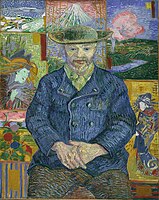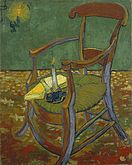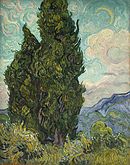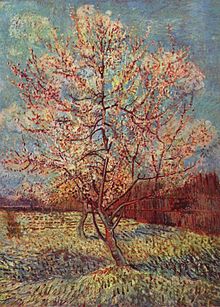#RIP #OTD in 1856 composer (Carnaval, Symphonic Studies, Kinderszenen, Kreisleriana, Fantasie in C), pianist, husband of Clara Wieck, Robert Schumann died from pneumonia in a sanatorium in Bonn, Germany at the age of 46. Alter Friedhof in Bonn with Clara
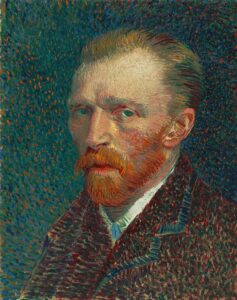 On this day in 1890, Dutch post-Impressionist painter Vincent van Gogh died from complications of a self-inflicted gunshot to the chest in Auvers-sur-Oise, France at the age of 37. Born Vincent Willem van Gogh on 30 March 1853 in Zundert, Netherlands. Perhaps my favorite artist. In my opinion, his work has had a far-reaching influence on art as a result of its vivid colors and emotional impact. Between his move to Paris and his discovery of the French Impressionists and his stay in Arles (accompanied for awhile by Paul Gauguin) he developed his highly recognizable style. Van Gogh never married.
On this day in 1890, Dutch post-Impressionist painter Vincent van Gogh died from complications of a self-inflicted gunshot to the chest in Auvers-sur-Oise, France at the age of 37. Born Vincent Willem van Gogh on 30 March 1853 in Zundert, Netherlands. Perhaps my favorite artist. In my opinion, his work has had a far-reaching influence on art as a result of its vivid colors and emotional impact. Between his move to Paris and his discovery of the French Impressionists and his stay in Arles (accompanied for awhile by Paul Gauguin) he developed his highly recognizable style. Van Gogh never married.
Van Gogh suffered from psychotic episodes and delusions and though he worried about his mental stability, he often neglected his physical health, did not eat properly and drank heavily. His friendship with Gauguin ended after a confrontation with a razor when, in a rage, he severed part of his own left ear. He spent time in psychiatric hospitals, including a period at Saint-Rémy. After he discharged himself and moved to the Auberge Ravoux in Auvers-sur-Oise near Paris, he came under the care of the homeopathic doctor Paul Gachet.
Van Gogh was unsuccessful during his lifetime, and was considered a madman and a failure. He became famous after his suicide, and exists in the public imagination as the quintessential misunderstood genius. His reputation began to grow in the early 20th century as elements of his painting style came to be incorporated by the Fauves and German Expressionists.
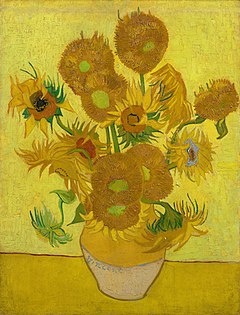
Sunflowers (F.458), repetition of the 4th version (yellow background), August 1889. Van Gogh Museum, Amsterdam
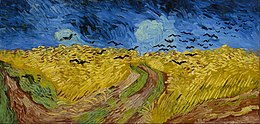
Wheatfield with Crows, 1890. Van Gogh Museum, Amsterdam
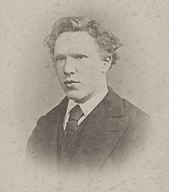
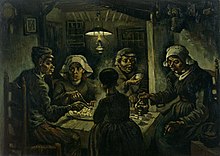
The Potato Eaters, 1885. Van Gogh Museum, Amsterdam
-
-

Worn Out, pencil on watercolour paper, 1882. Van Gogh Museum, Amsterdam
-
-
-
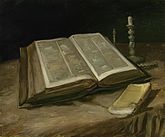
Still Life with Open Bible, Extinguished Candle and Novelalso Still Life with Bible, 1885. Van Gogh Museum, Amsterdam
-
-
-
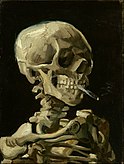
Skull of a Skeleton with Burning Cigarette, 1885–86. Van Gogh Museum, Amsterdam
-
-
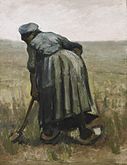
Peasant Woman Digging, or Woman with a Spade, Seen from Behind, 1885. Art Gallery of Ontario, Toronto
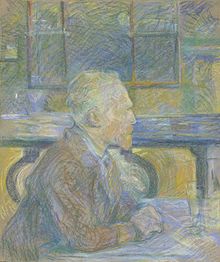
Henri de Toulouse-Lautrec, Portrait of Vincent van Gogh, 1887, pastel drawing, Van Gogh Museum, Amsterdam
-
-

Le Moulin de Blute-Fin (1886) from the Le Moulin de la Galette and Montmartre series’. Bridgestone Museum of Art, Tokyo (F273)
-
-
-

Courtesan (after Eisen), 1887. Van Gogh Museum, Amsterdam
-
-
-
Portrait of Père Tanguy, 1887. Musée Rodin, Paris
-
-
-
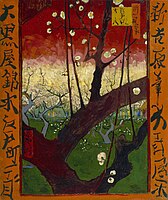
Flowering Plum Orchard (after Hiroshige), 1887. Van Gogh Museum, Amsterdam
-

The Yellow House, 1888. Van Gogh Museum, Amsterdam
-
-
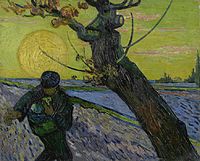
The Sower with Setting Sun, 1888. Van Gogh Museum, Amsterdam
-
-
-

Fishing Boats on the Beach at Saintes-Maries, June 1888. Van Gogh Museum, Amsterdam
-
-
-
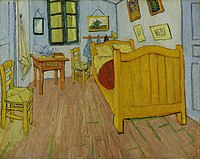
Bedroom in Arles, 1888. Van Gogh Museum, Amsterdam
-
-
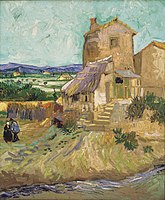
The Old Mill, 1888. Albright–Knox Art Gallery, Buffalo, New York

Paul Gauguin, The Painter of Sunflowers: Portrait of Vincent van Gogh, 1888. Van Gogh Museum, Amsterdam
-
-
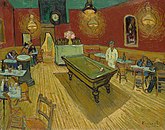
The Night Café, 1888. Yale University Art Gallery, New Haven, Connecticut
-
-
-

The Red Vineyard, November 1888. Pushkin Museum, Moscow. Sold to Anna Boch, 1890
-
-
-

Van Gogh’s Chair, 1888. National Gallery, London
-
-
-

Self-portrait with Bandaged Ear and Pipe, 1889, private collection
-
-
-
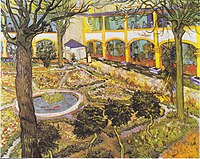
The Courtyard of the Hospital at Arles, 1889, Oskar Reinhart Collection “Am Römerholz”, Winterthur, Switzerland
-
-
-

Self-portrait with Bandaged Ear, 1889, Courtauld Institute of Art, London
-

The Starry Night, June 1889. Museum of Modern Art, New York
-
-

The Round of the Prisoners (after Doré), 1890. Pushkin Museum, Moscow
-
-
-

The Sower, (after Jean-François Millet), 1888. Kröller-Müller Museum, Otterlo
-
-
-
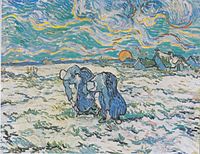
Two Peasant Women Digging in a Snow-Covered Field at Sunset, (after Jean-François Millet), 1890. Foundation E.G. Bührle Collection, Zurich, Switzerland
-
-

Sorrowing Old Man (‘At Eternity’s Gate’), 1890. Kröller-Müller Museum, Otterlo

White House at Night, 1890. Hermitage Museum, St Petersburg, painted six weeks before the artist’s death
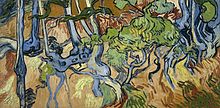
Tree Roots, July 1890, Van Gogh Museum, Amsterdam

The Church at Auvers, 1890. Musée d’Orsay, Paris
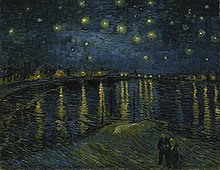
Starry Night Over the Rhone, 1888. Musée d’Orsay, Paris
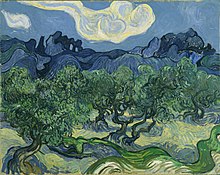
Olive Trees with the Alpilles in the Background, 1889. Museum of Modern Art, New York

Memory of the Garden at Etten, 1888. Hermitage Museum, St Petersburg

-
-

Portrait of Artist’s Mother, October 1888, Norton Simon Museum of Art, Pasadena, California
-
-
-
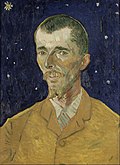
Eugène Boch, (The Poet Against a Starry Sky), 1888, Musée d’Orsay, Paris
-
-
-

Portrait of the Postman Joseph Roulin (1841–1903) early August 1888, Museum of Fine Arts, Boston
-
-
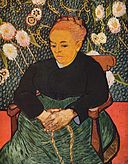
La Berceuse (Augustine Roulin)1889, Museum of Fine Arts, Boston

Self-Portrait, September 1889. Musée d’Orsay, Paris
-
-

Self-Portrait with Grey Felt Hat, Winter 1887–88. Van Gogh Museum, Amsterdam
-
-
-

Self-Portrait with Straw Hat, Paris, Winter 1887–88. Metropolitan Museum of Art, New York
-
-
-

Self-Portrait, 1889. National Gallery of Art, Washington, D.C. His Saint-Rémy self-portraits show his side with the unmutilated ear, as he saw himself in the mirror
-
-

Self-Portrait Without Beard, c. September 1889. This painting may have been Van Gogh’s last self-portrait. He gave it to his mother as a birthday gift.

Still Life: Vase with Fourteen Sunflowers, August 1888. National Gallery, London
-
-
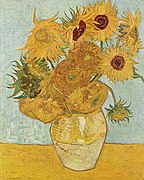
Still Life: Vase with Twelve Sunflowers, August 1888. Neue Pinakothek, Munich
-
-
-

Irises, 1889. J. Paul Getty Museum, Los Angeles
-
-
-

Almond Blossom, 1890. Van Gogh Museum, Amsterdam
-
-

Still Life: Pink Roses in a Vase, May 1890, Metropolitan Museum of Art, New York
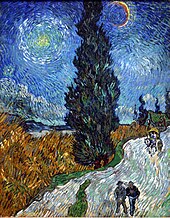
Road with Cypress and Star, May 1890, Kröller-Müller Museum, Otterlo
-
-

Cypresses in Starry Night, a reed pen drawing executed by Van Gogh after the painting in 1889
-
-
-
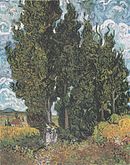
Cypresses and Two Women, 1890. Kröller-Müller Museum, Otterlo, Netherlands
-
-
-

Wheat Field with Cypresses, 1889. Metropolitan Museum of Art, New York
-
-

View of Arles, Flowering Orchards, 1889. Neue Pinakothek, Munich

Wheatfield Under Thunderclouds, 1890, Van Gogh Museum, Amsterdam, Netherlands
-
-

Enclosed Wheat Field with Rising Sun, May 1889, Kröller-Müller Museum, Otterlo, Netherlands
-
-
-

Rain or Enclosed Wheat Field in the Rain, November 1889, Philadelphia Museum of Art, Philadelphia
-
-
-

Wheat Fields, early June 1889. Kröller-Müller Museum, Otterlo
-
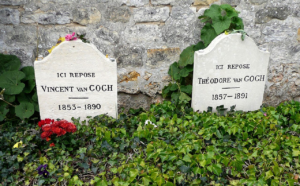 The Final Footprint – Van Gogh is interred in Auvers-sur-Oise Town Cemetery. His brother Theo apparently reported that van Gogh’s last words were, “The sadness will last forever.” Theo would die six months later. The brothers rest side-by-side. the Van Gogh Museum in Amsterdam, which holds the world’s largest collection of his paintings and drawings.
The Final Footprint – Van Gogh is interred in Auvers-sur-Oise Town Cemetery. His brother Theo apparently reported that van Gogh’s last words were, “The sadness will last forever.” Theo would die six months later. The brothers rest side-by-side. the Van Gogh Museum in Amsterdam, which holds the world’s largest collection of his paintings and drawings.
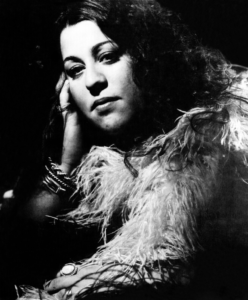 On this day in 1974, singer and actress Mama Cass, Cass Elliot died of heart failure in Harry Nilsson’s flat in Mayfair, London at the age of 32. Born Ellen Naomi Cohen on September 19, 1941 in . Perhaps best known for having been a member of the Mamas and the Papas. After the group broke up, she released five solo albums. In 1998, she was posthumously inducted into the Rock and Roll Hall of Fame for her work with the Mamas and the Papas.
On this day in 1974, singer and actress Mama Cass, Cass Elliot died of heart failure in Harry Nilsson’s flat in Mayfair, London at the age of 32. Born Ellen Naomi Cohen on September 19, 1941 in . Perhaps best known for having been a member of the Mamas and the Papas. After the group broke up, she released five solo albums. In 1998, she was posthumously inducted into the Rock and Roll Hall of Fame for her work with the Mamas and the Papas.
Elliot was married twice, the first time in 1963 to James Hendricks, her group mate in the Big 3 and the Mugwumps. This was reportedly a platonic arrangement to assist him in avoiding being drafted during the Vietnam War. The marriage reportedly was never consummated and was annulled in 1968. In 1971, Elliot married journalist Donald von Wiedenman, heir to a Bavarian barony. Their marriage ended in divorce after a few months.
The Final Footprint
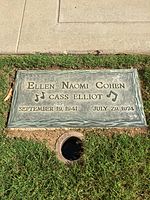
The flat where Elliot died, Flat 12, 9 Curzon Place (later Curzon Square), Shepherd Market, Mayfair, London, was on loan from Nilsson. Four years later, The Who’s drummer Keith Moon died in the same room, also aged 32 years.
Elliot’s body was cremated at the Hollywood Forever Cemetery in Los Angeles, California. Her cremated remains were later buried in Mount Sinai Memorial Park Cemetery in Los Angeles. Another notable final footprint at Mount Sinai; Don Rickles.
She is mentioned as the host of a party in the Elton John biopic, Rocketman. The party occurs after Elton’s first performance at the Troubador in Los Angeles. She is portrayed by Rachel Redleaf in the 2019 film Once Upon a Time…In Hollywood.
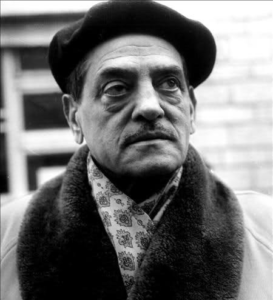 On this day in 1983, filmmaker Luis Buñuel died in Mexico City from diabetes complications at the age of 83. Born Luis Buñuel Portolés on 22 February 1900 in Calanda, Aragon, Spain.
On this day in 1983, filmmaker Luis Buñuel died in Mexico City from diabetes complications at the age of 83. Born Luis Buñuel Portolés on 22 February 1900 in Calanda, Aragon, Spain.
His first picture, Un Chien Andalou—made in the silent era—is still viewed regularly throughout the world and retains its power to shock the viewer. His last film, That Obscure Object of Desire—made 48 years later—won him Best Director awards from the National Board of Review and the National Society of Film Critics. Writer Octavio Paz called Buñuel’s work “the marriage of the film image to the poetic image, creating a new reality…scandalous and subversive”.
Often associated with the surrealist movement of the 1920s, Buñuel created films from the 1920s through the 1970s. Having worked in Europe and North America, and in French and Spanish, Buñuel’s films also spanned various genres. Despite this variety, filmmaker John Huston believed that, regardless of genre, a Buñuel film is so distinctive as to be instantly recognizable, or, as Ingmar Bergman put it, “Buñuel nearly always made Buñuel films”. My favorite film of his is Belle de Jour. It won the Golden Lion and the Pasinetti Award for Best Film at the Venice Film Festival in 1967.
Buñuel became an accomplished hypnotist. He was often to insist that watching movies was a form of hypnosis: “This kind of cinematographic hypnosis is no doubt due to the darkness of the theatre and to the rapidly changing scenes, lights, and camera movements, which weaken the spectator’s critical intelligence and exercise over him a kind of fascination.”
Starting at age 17, Buñuel steadily dated the future poet and dramatist Concha Méndez, with whom he vacationed every summer at San Sebastián. He introduced her to his friends at the Residencia as his fiancée. After five years, she broke off the relationship, citing Buñuel’s “insufferable character”.
In 1926 he met his future wife, Jeanne Rucar Lefebvre, a gymnastics teacher who had won a bronze medal at the 1924 Paris Olympics. Buñuel courted her in a formal Aragonese manner, complete with a chaperone. They married in 1934 and remained married until his death.
The Final Footprint
Long-time friend and collaborator, Jean-Claude Carrière
In 1982, he wrote (along with Carrière) his autobiography, Mon Dernier Soupir (My Last Sigh), which provides an account of his life, friends, and family as well as a representation of his eccentric personality. In it, he recounts dreams, encounters with many well-known writers, actors, and artists such as Pablo Picasso and Charlie Chaplin as well as antics, like dressing up as a nun and walking around town.
Buñuel once told his friend, novelist Carlos Fuentes: “I’m not afraid of death. I’m afraid of dying alone in a hotel room, with my bags open and a shooting script on the night table. I must know whose fingers will close my eyes.” Fuentes has recounted that Buñuel spent his last week in hospital discussing theology with the Jesuit brother Julián Pablo Fernández, a long time friend. His funeral was very private, involving only family and close friends, among them poets Octavio Paz and Homero Aridjis.
Buñuel was cremated.
#RIP #OTD in 1983 actor (Separate Tables, Murder by Death, Death on the Nile, The Pink Panther, James Bond in Casino Royale), soldier, memoirist, novelist David Niven died from ALS at his chalet in Château-d’Œx, Switzerland aged 73. Château-d’Œx Cemetery
Have you planned yours yet?
Follow TFF on twitter @RIPTFF


